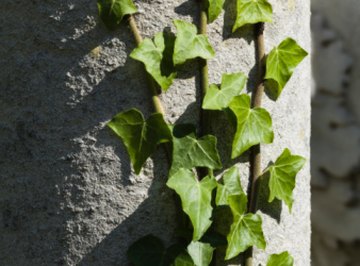
When attempting to identify a plant species that is new to you, determining leaf arrangement is one of the first steps. Understanding basic botanical terminology and plant anatomy will help you decide which of the three leaf arrangement types a plant exhibits. Alternate leaves, whorled leaves and opposite leaves are the three different types of leaf arrangements displayed by woody plants.
Basic Botanical Terminology
Phyllotaxy is a botanical term that refers to the arrangement of leaves on a plant stem. In order to determine leaf arrangement, it's useful to first understand the names for the parts of plant leaves and how leaves grow on stems.
In the most basic terms, the parts of a plant leaf are the blade, margin and petiole. The blade is the flat part of a leaf, the margin is the edge and the petiole is the leaf stalk. A node is a place where a leaf emerges from a plant stem.
Before deciding on leaf arrangement, another question must be considered first: Does the plant have simple or compound leaves? Simple leaves have one blade per petiole, while in compound leaves, the blade is composed of several leaflets. Simple leaves are attached to the stem of the plant by one petiole, and the leaflets of compound leaves are connected by a midrib, which is a central vein.
Leaf Arrangement Types
Plants with alternate leaf arrangement have one leaf per node, according to the University of Georgia Extension. This makes the leaves look like they are staggered on the stem of the plant. Some examples of trees with alternate leaf arrangement include oaks, birches, sycamores and willows. See a picture of a black birch tree, which exhibits alternate leaf arrangement, provided by the University of Maryland.
Opposite leaf arrangement means that the plant has two leaves per node, notes Palomar College. Growing in pairs directly opposite from each other, the leaves of maples, ashes, olives and eucalyptus exhibit opposite leaves. To see a clear illustration of opposite leaf arrangement, look at the picture shared by the University of Miami.
When plants have whorled leaves, this means that three or more leaves grow from a single node, according to the University of Illinois. While there are not many trees or shrubs with whorled leaves, southern catalpa (Catalpa bignonioides) is one example of a tree with whorled leaf arrangement.
The leaves of some lilies are also arranged in whorls, and sweet woodruff is a small plant with leaves that clearly illustrate whorled leaf arrangement. To see whorled plant leaves, check out the pictures of sweet woodruff provided by South Dakota State University Extension.
Beyond Leaf Arrangement
As you progress through a plant identification key to find the name of a new species, there are several more steps after determining leaf type and leaf arrangement. Examining the leaf edge, leaf texture, leaf venation and leaf shape can also provide clues about a plant's identity.
The edges – also called margins – of leaves can be smooth, toothed or lobed. Some descriptions of leaf textures include hairy, waxy, rough, smooth, thick and thin. When describing the veins in a leaf – the botanical term for this is venation – pinnate, parallel, palmate and reticulate are some of the words used to describe different patterns of veins in plant leaves.
Even more basic, the overall shape of a plant's leaves can be very useful in determining the genus and species of the specimen. Leaves grow in a wide variety of shapes, from linear to oblong to cordate. Check out the illustration provided by University of Illinois to see 17 names for different leaf shapes.
References
Resources
About the Author
Meg Schader is a freelance writer and copyeditor. She holds a Bachelor of Science in agriculture from Cornell University and a Master of Professional Studies in environmental studies from SUNY College of Environmental Science and Forestry. Along with freelancing, she also runs a small farm with her family in Central New York.
Photo Credits
Jupiterimages/Polka Dot/Getty Images
